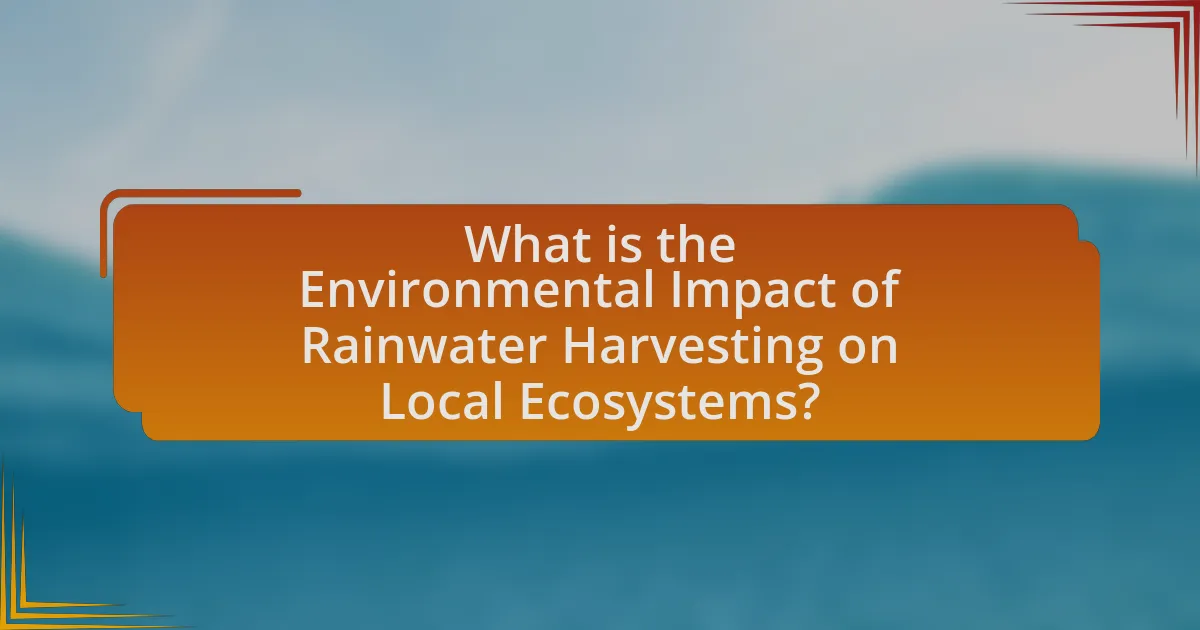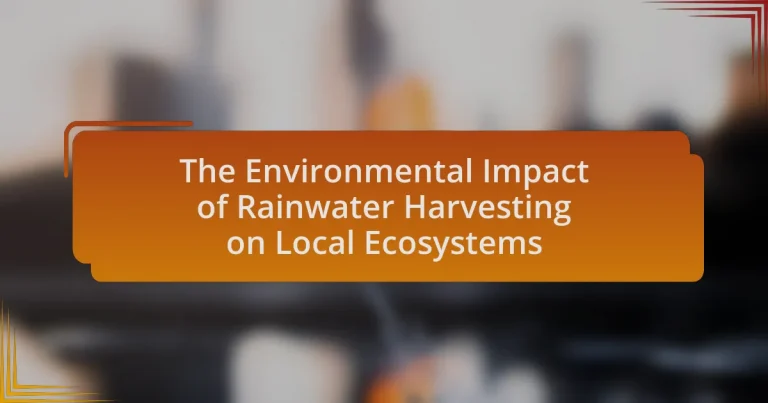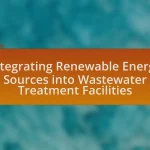Rainwater harvesting is a sustainable practice that significantly impacts local ecosystems by enhancing water availability, reducing surface runoff, and promoting biodiversity. This article explores the positive effects of rainwater harvesting on groundwater recharge, soil health, and local flora and fauna, while also addressing potential negative impacts such as water quality degradation and habitat disruption. Key processes involved in rainwater harvesting, best practices for implementation, and innovative technologies that enhance its efficiency are discussed, alongside strategies for community involvement and education to optimize outcomes. The article provides a comprehensive overview of how rainwater harvesting can contribute to ecological resilience and sustainable water management.
What is the Environmental Impact of Rainwater Harvesting on Local Ecosystems?

Rainwater harvesting positively impacts local ecosystems by enhancing water availability and reducing surface runoff. This practice allows for the replenishment of groundwater supplies, which supports vegetation and wildlife. Studies indicate that rainwater harvesting can lead to improved soil moisture levels, promoting plant growth and biodiversity. Additionally, it mitigates erosion and sedimentation in nearby water bodies, preserving aquatic habitats. Research conducted by the International Rainwater Harvesting Alliance shows that communities implementing rainwater harvesting systems experience increased resilience against droughts, further benefiting local ecosystems.
How does rainwater harvesting influence local water cycles?
Rainwater harvesting positively influences local water cycles by increasing groundwater recharge and reducing surface runoff. This practice captures rainwater that would otherwise flow into storm drains, allowing it to percolate into the soil, which enhances aquifer levels. Studies indicate that areas implementing rainwater harvesting can see a significant increase in groundwater levels, with some regions reporting improvements of up to 30% in aquifer recharge rates. Additionally, by mitigating surface runoff, rainwater harvesting helps reduce erosion and sedimentation in local waterways, contributing to healthier aquatic ecosystems.
What are the key processes involved in rainwater harvesting?
The key processes involved in rainwater harvesting include collection, storage, filtration, and distribution. Collection involves capturing rainwater from surfaces such as roofs, which directs the water into a storage system. Storage refers to the use of tanks or cisterns to hold the collected rainwater until it is needed. Filtration is essential to remove debris and contaminants from the water, ensuring its quality for use. Finally, distribution involves the system that delivers the harvested rainwater for various applications, such as irrigation or household use. These processes are critical for effective rainwater harvesting, contributing to water conservation and management.
How does rainwater harvesting affect groundwater levels?
Rainwater harvesting positively affects groundwater levels by increasing the amount of water that infiltrates into the ground. This practice captures rainwater that would otherwise run off surfaces, allowing it to percolate through the soil and recharge aquifers. Studies indicate that areas implementing rainwater harvesting can experience a rise in groundwater levels, with some research showing increases of up to 30% in local aquifer recharge rates. This enhanced infiltration contributes to sustainable water management and helps mitigate the effects of drought by maintaining groundwater supplies.
What are the ecological benefits of rainwater harvesting?
Rainwater harvesting provides significant ecological benefits, including the reduction of stormwater runoff and the replenishment of groundwater supplies. By capturing rainwater, this practice minimizes the volume of surface water that can lead to erosion, flooding, and water pollution in local ecosystems. Additionally, it enhances the availability of water for plants and wildlife, promoting biodiversity. Studies indicate that rainwater harvesting can improve soil moisture levels, which supports vegetation growth and contributes to healthier ecosystems. Furthermore, it reduces the demand on municipal water systems, leading to lower energy consumption associated with water treatment and distribution.
How does rainwater harvesting contribute to biodiversity?
Rainwater harvesting contributes to biodiversity by creating habitats that support various plant and animal species. The practice allows for the collection and storage of rainwater, which can be used to irrigate gardens and green spaces, promoting the growth of native vegetation. This increase in native plants provides food and shelter for local wildlife, enhancing ecosystem diversity. Studies have shown that areas utilizing rainwater harvesting techniques often exhibit higher levels of species richness compared to those relying solely on conventional water sources, as the availability of water encourages the establishment of diverse flora and fauna.
What role does rainwater harvesting play in soil health?
Rainwater harvesting significantly enhances soil health by improving moisture retention and reducing erosion. This practice allows for the direct collection and storage of rainwater, which can then be used to irrigate crops and replenish groundwater. Studies show that areas utilizing rainwater harvesting techniques experience increased soil moisture levels, leading to better plant growth and higher organic matter content in the soil. Additionally, by minimizing surface runoff, rainwater harvesting helps prevent soil erosion, thereby maintaining soil structure and fertility.
What are the potential negative impacts of rainwater harvesting?
Rainwater harvesting can lead to several potential negative impacts, including water quality issues, habitat disruption, and increased mosquito breeding. Water quality can be compromised due to contaminants from roofs and storage systems, which may introduce pathogens and pollutants into the harvested water. Habitat disruption occurs when large-scale rainwater harvesting alters local hydrology, potentially affecting the natural water cycle and ecosystems dependent on consistent water flow. Additionally, stagnant water in storage systems can create breeding grounds for mosquitoes, increasing the risk of vector-borne diseases. These impacts highlight the importance of careful planning and management in rainwater harvesting systems to mitigate adverse effects on local ecosystems.
How can rainwater harvesting lead to habitat disruption?
Rainwater harvesting can lead to habitat disruption by altering the natural water flow and availability in local ecosystems. This practice often involves collecting and storing rainwater, which can reduce the amount of water that naturally replenishes local rivers, streams, and groundwater systems. Consequently, the decreased water flow can negatively impact aquatic habitats, leading to reduced biodiversity and changes in species composition. For instance, studies have shown that significant alterations in hydrology can result in the loss of wetland areas, which are crucial for many species’ survival. Additionally, the concentration of pollutants in harvested rainwater can affect soil and water quality, further disrupting local habitats.
What are the risks of water quality degradation from rainwater harvesting?
The risks of water quality degradation from rainwater harvesting include contamination from pollutants, pathogens, and sediment. Rainwater can collect debris, chemicals, and microorganisms from rooftops and gutters, which may lead to health hazards if not properly filtered or treated. Studies indicate that rainwater can harbor bacteria such as E. coli and other pathogens, posing risks to human health. Additionally, heavy metals and organic pollutants can leach into the harvested water, particularly in urban areas where roofs may contain harmful substances. Proper maintenance and filtration systems are essential to mitigate these risks and ensure safe water quality.
How does rainwater harvesting interact with local flora and fauna?
Rainwater harvesting positively interacts with local flora and fauna by enhancing water availability and promoting biodiversity. The collection and storage of rainwater can lead to increased soil moisture, which supports plant growth and improves the health of local vegetation. This, in turn, provides habitat and food sources for various animal species, fostering a more diverse ecosystem. Studies have shown that areas utilizing rainwater harvesting techniques often experience a resurgence in native plant species, which attracts pollinators and other wildlife, thereby strengthening ecological networks.
What species benefit from rainwater harvesting systems?
Rainwater harvesting systems benefit various species, particularly plants, amphibians, and birds. These systems provide a reliable water source that supports plant growth, especially in arid regions, enhancing biodiversity. For example, native vegetation can thrive, which in turn supports local wildlife. Amphibians, such as frogs, benefit from the increased availability of water bodies for breeding, while birds rely on the vegetation and water sources for food and habitat. Studies indicate that areas utilizing rainwater harvesting show improved ecosystem health and species diversity, demonstrating the positive impact of these systems on local ecosystems.
How can rainwater harvesting affect invasive species dynamics?
Rainwater harvesting can influence invasive species dynamics by altering local water availability and habitat conditions. By collecting and storing rainwater, this practice can create new water sources that may favor the establishment and proliferation of invasive species, which often thrive in disturbed or altered environments. For instance, studies have shown that increased water availability can enhance the growth of invasive plant species, outcompeting native flora and disrupting local ecosystems. Additionally, the introduction of rainwater harvesting systems can change soil moisture levels, potentially favoring invasive species that are adapted to such conditions, thereby impacting biodiversity and ecosystem health.
What are the best practices for implementing rainwater harvesting?
The best practices for implementing rainwater harvesting include selecting appropriate collection surfaces, ensuring proper filtration and storage systems, and adhering to local regulations. Using clean, non-toxic materials for roofs and gutters maximizes water quality, while installing first-flush diverters prevents initial contaminants from entering storage tanks. Additionally, using cisterns made from food-grade materials and maintaining regular cleaning schedules for both collection and storage systems enhances water safety. Following these practices not only improves the efficiency of rainwater harvesting systems but also minimizes potential negative impacts on local ecosystems by ensuring that harvested water is clean and safe for use.
How can communities effectively design rainwater harvesting systems?
Communities can effectively design rainwater harvesting systems by assessing local rainfall patterns, determining appropriate storage capacity, and selecting suitable collection materials. Analyzing historical rainfall data allows communities to estimate the volume of water that can be harvested, ensuring that the system is tailored to local conditions. For instance, regions with an average annual rainfall of 800 mm can benefit from systems designed to capture and store significant portions of that water, reducing reliance on other water sources. Additionally, using materials like food-grade plastic or galvanized steel for storage tanks ensures water quality and safety. Implementing filtration systems can further enhance water quality, making it suitable for various uses.
What maintenance practices ensure the sustainability of rainwater harvesting systems?
Regular maintenance practices that ensure the sustainability of rainwater harvesting systems include routine inspection, cleaning of catchment surfaces, and maintenance of storage tanks. Routine inspections help identify leaks, blockages, or structural issues that could compromise system efficiency. Cleaning catchment surfaces, such as roofs and gutters, prevents debris accumulation, which can contaminate the harvested water. Additionally, maintaining storage tanks by checking for sediment buildup and ensuring proper sealing protects water quality and system integrity. These practices are essential for maximizing the efficiency and longevity of rainwater harvesting systems, thereby supporting their role in sustainable water management.
What are the common challenges faced in rainwater harvesting?
Common challenges faced in rainwater harvesting include inadequate infrastructure, contamination risks, and seasonal variability in rainfall. Inadequate infrastructure can lead to inefficient collection and storage systems, resulting in water loss. Contamination risks arise from pollutants on rooftops and in storage tanks, which can compromise water quality. Seasonal variability affects the reliability of supply, as inconsistent rainfall can lead to periods of scarcity. These challenges can hinder the effectiveness and sustainability of rainwater harvesting systems, impacting their overall contribution to local ecosystems.
How can communities overcome regulatory hurdles in rainwater harvesting?
Communities can overcome regulatory hurdles in rainwater harvesting by actively engaging with local governments to advocate for supportive policies. This engagement can include forming coalitions to demonstrate community interest, providing data on the benefits of rainwater harvesting, and showcasing successful case studies from other regions. For instance, a study by the American Rainwater Catchment Systems Association highlights that communities that collaborated with regulatory bodies saw a 30% increase in permitted rainwater harvesting systems. By presenting evidence of environmental benefits, such as reduced stormwater runoff and improved water quality, communities can effectively influence policy changes that facilitate rainwater harvesting initiatives.
What strategies can be employed to educate the public about rainwater harvesting benefits?
To educate the public about the benefits of rainwater harvesting, community workshops and informational campaigns can be employed. These strategies facilitate direct engagement and provide practical demonstrations of rainwater harvesting systems, showcasing their efficiency and environmental advantages. Research indicates that hands-on learning significantly enhances retention of information, making workshops effective in conveying the benefits of reduced water bills and decreased reliance on municipal water sources. Additionally, utilizing social media platforms to share success stories and data on water conservation can reach a broader audience, reinforcing the positive impact of rainwater harvesting on local ecosystems.
How can rainwater harvesting be optimized for local ecosystems?
Rainwater harvesting can be optimized for local ecosystems by integrating natural filtration systems and native vegetation into the design. Utilizing bioswales and rain gardens allows for the natural absorption and filtration of rainwater, which enhances groundwater recharge and supports local flora and fauna. Studies have shown that these systems can improve water quality by reducing pollutants and sediment runoff, thereby benefiting aquatic ecosystems. Additionally, incorporating native plants in rainwater harvesting systems promotes biodiversity and provides habitat for local wildlife, further enhancing ecosystem resilience.
What innovative technologies are enhancing rainwater harvesting efficiency?
Innovative technologies enhancing rainwater harvesting efficiency include smart sensors, advanced filtration systems, and automated storage management. Smart sensors monitor rainfall and water levels in real-time, optimizing collection and usage. Advanced filtration systems improve water quality by removing contaminants, ensuring safe storage and use. Automated storage management systems regulate water distribution based on demand, maximizing efficiency. These technologies collectively increase the effectiveness of rainwater harvesting, contributing to sustainable water management practices.
How can community involvement improve rainwater harvesting outcomes?
Community involvement can significantly improve rainwater harvesting outcomes by fostering local ownership and ensuring sustainable practices. When communities actively participate in the planning and implementation of rainwater harvesting systems, they are more likely to maintain and utilize these systems effectively. Studies have shown that community-led initiatives often result in higher rates of system adoption and maintenance, as local stakeholders are more invested in the success of the project. For instance, a case study in India demonstrated that villages with strong community engagement achieved a 30% increase in water collection efficiency compared to those without such involvement. This engagement not only enhances the technical performance of rainwater harvesting systems but also promotes environmental awareness and stewardship among community members.


